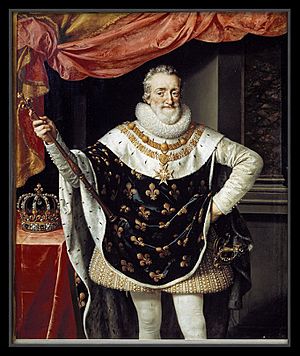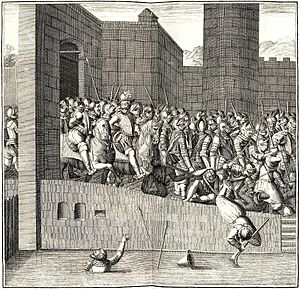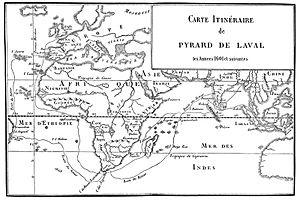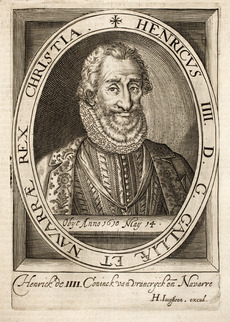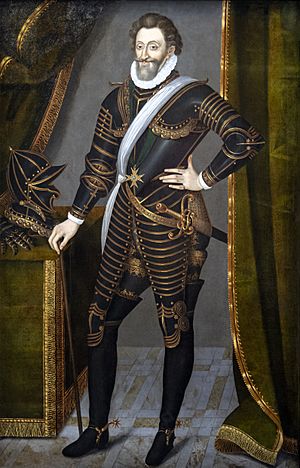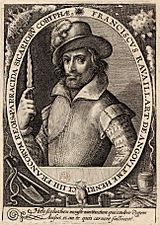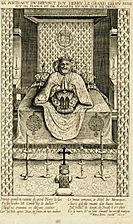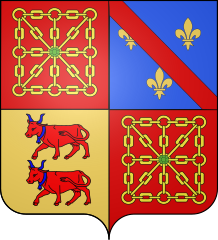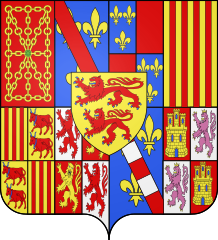Henry IV of France facts for kids
Quick facts for kids Henry IV |
|
|---|---|

Portrait by Frans Pourbus the Younger, 1610
|
|
| King of France (more...) | |
| Reign | 2 August 1589 – 14 May 1610 |
| Coronation | 27 February 1594 Chartres Cathedral |
| Predecessor | Henry III |
| Successor | Louis XIII |
| King of Navarre | |
| Reign | 9 June 1572 – 14 May 1610 |
| Predecessor | Jeanne III |
| Successor | Louis II |
| Born | 13 December 1553 Château de Pau, Pau, Béarn |
| Died | 14 May 1610 (aged 56) Palais du Louvre, Paris, France |
| Burial | 1 July 1610 Basilica of St Denis, Paris, France |
| Spouse |
|
| Issue |
|
| House | Bourbon |
| Father | Antoine of Navarre |
| Mother | Jeanne III of Navarre |
| Religion | Calvinism (1553–1595) Catholicism (1593–1610) |
| Signature |  |
| Cause of death | Assassination |
| Royal styles of King Henry IV Par la grâce de Dieu, Roi de France et de Navarre |
|
|---|---|
 |
|
| Reference style | His Most Christian Majesty |
| Spoken style | Your Most Christian Majesty |
| Alternative style | Sire |
Henry IV (French: Henri IV; 13 December 1553 – 14 May 1610) was a very important king in French history. People called him Good King Henry or Henry the Great. He was King of Navarre (as Henry III) from 1572 and became King of France in 1589. He was the first king from the House of Bourbon. Henry IV helped end the long and difficult French Wars of Religion. Sadly, he was assassinated in 1610 and his son, Louis XIII, became king.
Contents
Childhood and Teenage Years

Henry de Bourbon was born in Pau, the capital of the Kingdom of Navarre. His parents were Queen Joan III of Navarre and Antoine de Bourbon. Even though he was baptized Catholic, his mother raised him as a Protestant.
As a teenager, Henry joined the Huguenots (French Protestants) in the French Wars of Religion. When his mother died on June 9, 1572, the 19-year-old Henry became King of Navarre.
First Marriage and a Terrible Massacre
After his mother's death, Henry was set to marry Margaret of Valois. She was the daughter of Henry II of France and Catherine de' Medici. Their wedding took place in Paris on August 18, 1572.
Just six days later, on August 24, the St. Bartholomew's Day massacre began in Paris. Thousands of Protestants who had come for Henry's wedding were killed. Many more died across the country in the following days. Henry himself barely survived. He was forced to convert to Catholicism and live at the French court. However, he escaped in early 1576. He then officially returned to the Protestant faith and rejoined the Protestant forces.
The Wars of Religion
In 1584, Henry became the next in line to the French throne. This happened after Francis, Duke of Anjou died. Francis was the brother of the Catholic King Henry III of France. Since Henry of Navarre was the closest male relative of King Louis IX of France, King Henry III had to accept him as his successor.
War of the Three Henrys (1587–1589)
France was then plunged into a new part of the Wars of Religion. It was called the War of the Three Henrys because three powerful men named Henry were involved:
- King Henry III of France, supported by royalists.
- King Henry of Navarre, the Protestant leader, supported by Queen Elizabeth I of England.
- Henry I, Duke of Guise, leader of the Catholic League, supported by Philip II of Spain.
French law (called Salic law) meant that women could not inherit the throne. Since Henry of Navarre was a Protestant, many people did not want him to be king.
In December 1588, King Henry III had Henry I of Guise murdered. He hoped this would bring back his power. But people were shocked, and many cities turned against him. King Henry III then had to rely on King Henry of Navarre and his Protestant forces.
The two kings worked together to fight the Catholic League. King Henry III saw Henry of Navarre as a loyal Frenchman. They marched towards Paris. But on August 2, 1589, King Henry III was assassinated by a monk.
King of France: Early Years
Becoming King (1589–1594)

When Henry III died, Henry of Navarre became the new King of France. However, the Catholic League, with help from Spain, refused to accept him. The Pope even said Henry had no right to the crown. Most Catholic nobles left Henry. He had to fight to win his kingdom, with money from England and soldiers from Germany.
Henry won battles like the Battle of Arques and the Battle of Ivry. But he could not capture Paris after trying to besiege it in 1590.

When the Catholic League's chosen king, Cardinal de Bourbon, died in 1590, they couldn't agree on a new leader. Spain wanted Infanta Isabella Clara Eugenia of Spain to be queen. But the French Parliament said that French law did not allow a woman to rule. They also said that France should not let foreign powers choose their king.
Despite these problems for the League, Henry still could not take control of Paris.
Converting to Catholicism: "Paris is Well Worth a Mass" (1593)
On July 25, 1593, Henry decided to become Catholic. He did this to secure his place as King of France. He is famously said to have declared, Paris vaut bien une messe ("Paris is well worth a mass"). This meant that becoming king of France was worth changing his religion. This decision made many of his Protestant supporters unhappy.
His conversion helped him gain the support of most French people.
Coronation and Recognition (1594–1595)
The traditional place for French kings to be crowned, Reims, was still held by the Catholic League. So, Henry was crowned King of France at the Cathedral of Chartres on February 27, 1594. The Pope officially accepted Henry as king on September 17, 1595.
Henry did not forget his Protestant friends. He was known for being religiously tolerant. In 1598, he issued the Edict of Nantes. This important law gave Protestants certain religious freedoms and rights. It effectively ended the long and bloody French Wars of Religion.
Ending the Civil Wars
Henry IV successfully ended the civil wars in France. He used money to calm Catholic leaders. He also used the Edict of Nantes to satisfy Protestant leaders. This Edict had four parts. It explained where Protestants could worship and recognized three Protestant universities. It also allowed their church meetings. The king also issued special documents that supported the Protestant establishment. The Edict of Nantes made religious tolerance a law.
Even with these efforts, it took years to fully restore peace and order in France. Some local parliaments did not want to accept the Edict.
Later Years as King
Domestic Policies: Building a Strong France
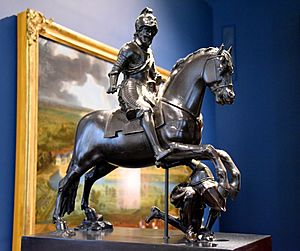
During his reign, Henry IV worked with his minister, Maximilien de Béthune, Duke of Sully. They worked to improve France's finances, help farming, and build public works. They also encouraged education. Henry and Sully protected forests and built tree-lined roads, bridges, and canals. He even had a long canal built in the park at the Château Fontainebleau.
The King made Paris a great city again. He built the Pont Neuf bridge, which still stands today. He also built the Place Royale (now Place des Vosges) and added the Grande Galerie to the Louvre Palace. This huge addition was over 400 meters long. Henry IV invited artists and craftsmen to live and work in the Louvre. The art and buildings from his time are known as the "Henry IV style."
Henry IV also wanted France to make more of its own goods instead of importing them. He passed laws to limit the use of expensive imported fabrics. He also built royal factories to produce luxury items like crystal glass, silk, and tapestries. He helped silk weaving in Tours and Lyon and increased linen production. To help farmers, he gave out free copies of a farming manual.
King Henry also supported explorations beyond France. He helped finance expeditions to North America, leading to France claiming New France (now Canada).
International Relations: France and Other Countries
During Henry IV's reign, France continued its rivalry with the Habsburg rulers of Spain and the Holy Roman Empire. This was a struggle for power in Western Europe.
Spain and Italy
Spain had supported the Catholic League against Henry. Spanish armies intervened in 1590 and 1592. After Henry's coronation, the war continued. But after a victory at the Siege of Amiens in 1597, the Peace of Vervins was signed in 1598. This allowed Henry to focus on other issues.
Henry also had conflicts with Savoy. Their disputes were settled in the Treaty of Lyon of 1601. This treaty changed some land ownership between France and the Duchy of Savoy. Henry also helped the Dutch by sending them money.
Ottoman Empire

Henry continued France's alliance with the Ottoman Empire. In 1604, a "Peace Treaty and Capitulation" was signed. This gave France many benefits in the Ottoman Empire. He also sent ambassadors to Morocco and Tunisia to maintain friendly relations.
East Asia
Henry IV also wanted to develop trade with faraway lands. In 1600, a company was formed to trade with the Moluccas and Japan. Two ships were sent in 1601. One ship, the Corbin, was wrecked in the Maldives. The other, the Croissant, reached Ceylon and traded in Sumatra.
From 1604 to 1609, Henry tried to create a French East India Company. This was similar to companies in England and the Netherlands. He gave merchants exclusive rights to Asian trade for 15 years.
Religion: A King of Two Faiths
Henry IV was born Catholic but raised Protestant by his mother. In 1572, he was forced to convert to Catholicism after the massacre of Protestants. But in 1576, he escaped Paris and returned to Protestantism.
In 1593, to become King of France, he converted to Catholicism again. Even though he was officially Catholic, he valued his Protestant upbringing. He was tolerant towards the Huguenots until his death. The Edict of Nantes granted them many important rights.
Nicknames: Good King Henry
Henry was called "the Great" (Henri le Grand). In France, people also called him le bon roi Henri ("the good king Henry"). He was also known as le vert galant ("The Green Gallant"). In English, he is often called Henry of Navarre.
Assassination: A Sad End
Henry was the target of many assassination attempts. Some people thought he was a false king, while others thought he had betrayed his Protestant faith.
Henry was killed in Paris on May 14, 1610. A Catholic extremist named François Ravaillac stabbed him in the street. Henry's carriage was stopped in traffic. Ravaillac was quickly caught and executed a few days later. Henry was buried at the Saint Denis Basilica.
His wife, Marie de' Medici, became the ruler for their nine-year-old son, Louis XIII, until 1617.
-
Henry IV lying in state at the Louvre, an engraving after François Quesnel.
Legacy: A King Remembered
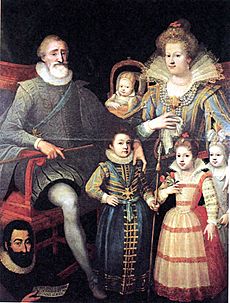
In 1614, a statue of Henry IV was put up on the Pont Neuf bridge. During the early days of the French Revolution, people saw Henry IV as a good example for kings. Even though his statue was later torn down, it was the first royal monument to be rebuilt in 1818. It still stands on the Pont Neuf today.
People remembered Henry IV fondly during the time when the Bourbon kings returned to power. The song "Long Live Henry IV" was very popular. When a new male heir to the throne was born, he was named Henri after Henry IV. He was even baptized with Jurançon wine and garlic, just like Henry IV had been in Pau.
Henry IV also inspired the character of King Ferdinand in William Shakespeare's play Love's Labour's Lost.
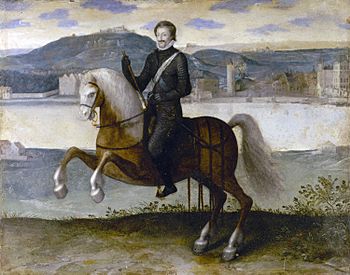
The first biography of Henry IV, Histoire du Roy Henry le Grand, was published in 1661. It was written for his grandson, King Louis XIV.
Some historical records about Henry IV, especially those by his minister Sully, were later found to be changed. This was done to make Henry IV's achievements seem even greater.
Family Tree
You can see Henry IV's family tree below:
| Ancestors of Henry IV of France | |||||||||||||||||||||||||||||||||||||||||||||||||||||||||||||||||||||||||||||||||||||||||||||||||||||||||||||||||||||||||||||||||||||||||||||||||||||||||||||||||||||||||||||||||||||||||||||||||||||||||||||||||||||||||||||||||||||||||||||||||||||||||||||||||||||||||||||||||||||||||
|---|---|---|---|---|---|---|---|---|---|---|---|---|---|---|---|---|---|---|---|---|---|---|---|---|---|---|---|---|---|---|---|---|---|---|---|---|---|---|---|---|---|---|---|---|---|---|---|---|---|---|---|---|---|---|---|---|---|---|---|---|---|---|---|---|---|---|---|---|---|---|---|---|---|---|---|---|---|---|---|---|---|---|---|---|---|---|---|---|---|---|---|---|---|---|---|---|---|---|---|---|---|---|---|---|---|---|---|---|---|---|---|---|---|---|---|---|---|---|---|---|---|---|---|---|---|---|---|---|---|---|---|---|---|---|---|---|---|---|---|---|---|---|---|---|---|---|---|---|---|---|---|---|---|---|---|---|---|---|---|---|---|---|---|---|---|---|---|---|---|---|---|---|---|---|---|---|---|---|---|---|---|---|---|---|---|---|---|---|---|---|---|---|---|---|---|---|---|---|---|---|---|---|---|---|---|---|---|---|---|---|---|---|---|---|---|---|---|---|---|---|---|---|---|---|---|---|---|---|---|---|---|---|---|---|---|---|---|---|---|---|---|---|---|---|---|---|---|---|---|---|---|---|---|---|---|---|---|---|---|---|---|---|---|---|---|---|---|---|---|---|---|---|---|---|---|---|---|---|---|---|---|
|
|||||||||||||||||||||||||||||||||||||||||||||||||||||||||||||||||||||||||||||||||||||||||||||||||||||||||||||||||||||||||||||||||||||||||||||||||||||||||||||||||||||||||||||||||||||||||||||||||||||||||||||||||||||||||||||||||||||||||||||||||||||||||||||||||||||||||||||||||||||||||
Marriages and Children
On August 18, 1572, Henry married his cousin Margaret of Valois. They did not have any children, and their marriage was ended in 1599. It was very important for Henry to have an heir to the throne.
Henry then married Marie de' Medici on December 17, 1600. They had six children:
| Name | Birth | Death | Notes |
|---|---|---|---|
| Louis XIII, King of France | 27 September 1601 | 14 May 1643 | Married Anne of Austria in 1615 |
| Elisabeth, Queen of Spain | 22 November 1602 | 6 October 1644 | Married Philip IV, King of Spain, in 1615 |
| Christine Marie, Duchess of Savoy | 10 February 1606 | 27 December 1663 | Married Victor Amadeus I, Duke of Savoy, in 1619 |
| Nicolas Henri, Duke of Orléans | 16 April 1607 | 17 November 1611 | |
| Gaston, Duke of Orléans | 25 April 1608 | 2 February 1660 | Married (1) Marie de Bourbon, Duchess of Montpensier, in 1626 Married (2) Marguerite of Lorraine in 1632 |
| Henrietta Maria, Queen of England, Queen of Scots, and Queen of Ireland | 25 November 1609 | 10 September 1669 | Married Charles I, King of England, King of Scots and King of Ireland, in 1625 |
Second Marriage
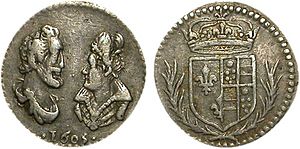
Henry's first marriage was not happy, and they had no children. After his first marriage was annulled in 1599, Henry married Marie de' Medici in 1600. She was the daughter of the Grand Duke of Tuscany.
Royal Symbols
The symbols used by Henry IV changed during his life:
See also
 In Spanish: Enrique IV de Francia para niños
In Spanish: Enrique IV de Francia para niños



